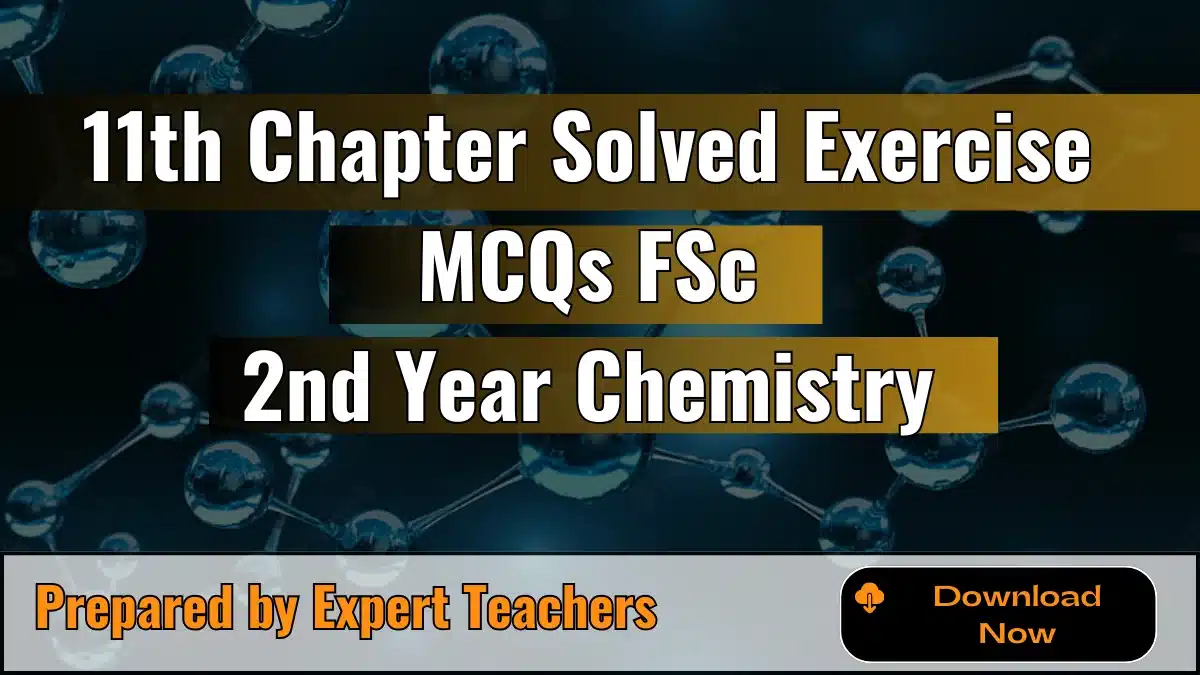14th Chapter Solved Exercise MCQs of FSC Second Year Chemistry
The 14th Chapter Solved Exercise MCQs of FSC 2nd-year Chemistry provides a complete set of solved multiple-choice questions (MCQs). Each MCQ comes with a brief explanation to help you understand the correct answer. These solutions are designed to support students in preparing for their exams, making complex concepts easier to grasp and ensuring a solid foundation for success.
14th chapter solved MCQs with explanation
1. In which of these processes are small organic molecules made into macromolecules?
(a) the cracking of petroleum fractions
(b) the fractional distillation of crude oil
(c) the polymerization of ethene
(d) the hydrolysis of proteins
Explanation: Option (c) is correct. Because Polymerization is when small molecules (monomers) join together to form large molecules (polymers). In this case, ethene molecules combine to create polyethylene, a macromolecule.
Other options:
- (a) Cracking of petroleum fractions: Breaks large molecules into smaller ones.
- (b) Fractional distillation of crude oil: Separates crude oil into different fractions.
- (d) Hydrolysis of proteins: Breaks down proteins into smaller parts like amino acids.
2. Which of these polymers is an addition polymer?
(a) nylon-6,6
(b) polystyrene
(c) terylene
(d) epoxy resin
Explanation: Option (b) is correct. Because Polystyrene is an addition polymer made from the monomer styrene, which has a double bond that links together to form the polymer.
In contrast:
- Nylon-6,6 is a condensation polymer made from a diamine and a dicarboxylic acid.
- Terylene (polyester) is also a condensation polymer made from a dicarboxylic acid and a diol.
- Epoxy resin is formed by cross-linking reactions, not addition polymerization.
3. Which of these polymers is a synthetic polymer?
(a) animal fat
(b) starch
(c) cellulose
(d) polyester
Explanation: Option (d) is correct. Because Polyester is a synthetic polymer, which means it is man-made through chemical processes. Unlike natural polymers such as animal fat, starch, and cellulose, which are derived from natural sources, polyester is created from petrochemical products and is used in a variety of industrial and consumer applications.
4. Plastics are a pollution problem because many plastics:
(a) are made from petroleum
(b) are very inflammable
(c) burn to produce toxic fumes
(d) decompose to produce toxic products
Explanation: Option (c) is correct. Because many plastics, made from petroleum, release harmful toxic fumes when burned. These fumes can be dangerous to health and the environment. Plastics are not easily decomposed and persist in the environment, but the primary pollution issue arises from the toxic emissions during incineration.
5. The fiber which is made from acrylonitrile as monomer:
(a) PVC
(b) rayon fiber
(c) acrylic fiber
(d) polyester fiber
Explanation: Option (c) is correct. Because Acrylonitrile is the monomer used in acrylic fiber production. This makes acrylic fibers similar in texture to wool and gives them properties like warmth and softness. The other options are different types of fibers or materials not based on acrylonitrile.
6. A polymeric substance that is formed in the liquid state and then hardened to a rigid solid is called a:
(a) fiber
(b) plastic
(c) varnish
(d) Polyamide resin
Explanation: Option (b) is correct. Because a plastic is a polymeric material that starts in a liquid or malleable state and then hardens into a solid form. This process allows it to be molded into various shapes. Fibers and varnishes are different types of materials, while polyamide resin is a specific type of plastic.
7. Vegetable oils are:
(a) unsaturated fatty acids
(b) glycerides of unsaturated fatty acids
(c) glycerides of saturated fatty acids
(d) essential oils obtained from plants
Explanation: Option (b) is correct. Because Vegetable oils primarily consist of triglycerides, which are esters formed from glycerol and unsaturated fatty acids. The unsaturated fatty acids have one or more double bonds in their carbon chains, which makes the oils liquid at room temperature. This is in contrast to saturated fatty acids, which are found in animal fats and are solid at room temperature.
8. Which one of the following elements is not present in all proteins?
(a) carbon
(b) hydrogen
(c) nitrogen
(d) sulphur
Explanation: Option (d) is correct. Because Proteins are made up of carbon, hydrogen, nitrogen, and oxygen, with these four elements being essential for their structure. Sulphur is present in some proteins, especially those with sulfur-containing amino acids like cysteine and methionine, but not all proteins contain sulphur. Therefore, sulphur is not a universal component of all proteins.
9. Which one of the following nitrogenous bases is not present in RNA?
(a) cytosine
(b) adenine
(c) thiamine
(d) uracil
Explanation: Option (c) is correct. Because RNA (ribonucleic acid) contains the nitrogenous bases adenine, cytosine, guanine, and uracil. Thiamine is not found in RNA; it is one of the nitrogenous bases in DNA (deoxyribonucleic acid). In RNA, uracil replaces thymine (thiamine) from DNA.
10. Which one of the following enzymes brings about the hydrolysis of fats?
(a) urease
(b) maltase
(c) zymase
(d) lipase
Explanation: Option (d) is correct. Because Lipase is the enzyme that catalyzes the hydrolysis of fats (triglycerides) into glycerol and fatty acids. Urease breaks down urea, maltase breaks down maltose into glucose, and zymase is involved in ethanol fermentation, not fat hydrolysis.
11. The reaction between fat and NaOH is called:
(a) Esterification
(b) Hydrogenolysis
(c) Fermentation
(d) Saponification
Explanation: Option (d) is correct. Because Saponification is the chemical reaction between a fat (or oil) and sodium hydroxide (NaOH) to produce glycerol and soap. This process is commonly used in soap-making. The reaction involves the hydrolysis of the ester bonds in the fat, leading to the formation of fatty acid salts (soap) and glycerol.
12. Which one of the following statements about glucose and sucrose is incorrect?
(a) both are soluble in water
(b) both are naturally occurring
(c) both are carbohydrates
(d) both are disaccharides
Explanation: Option (d) is correct. Because
- Glucose is a monosaccharide, which means it’s a single sugar unit.
- Sucrose is a disaccharide, made up of two sugar units (glucose and fructose).
So, while both glucose and sucrose are carbohydrates and are soluble in water, glucose is not a disaccharide like sucrose.







Leave a Reply